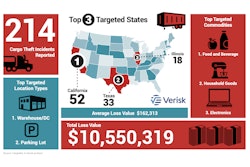
Much-anticipated changes to federal regulations governing truckers’ hours of service were announced today and are expected to take effect in late September.
Federal Motor Carrier Safety Administration Acting Administrator James Mullen announced the final rule that includes several changes, including:
- drivers will be allowed to use their 30-minute break in an on-duty, not-driving status and requiring it within their first eight hours of drive time, rather than their first eight hours on-duty
- modifies the sleeper-berth exception to allow drivers to split their 10-hour off-duty period into windows of seven hours and three hours, in addition to the existing eight-hour, two-hour option. It also adds the shorter period in any split off-duty will pause the rolling on-duty clock
- allows drivers to extend their drive-time limit and their on-duty window by two hours if they encounter adverse weather conditions or traffic congestion
- changes the short-haul exception available to some commercial drivers by lengthening their maximum on‑duty period from 12 to 14 hours and extending the distance limit within which the driver may operate from 100 air miles to 150 air miles
Trucking organizations today reacted to the changes, which come after numerous listening sessions held by FMCSA officials at several major truck shows and other venues.
Truckload Carriers Association
TCA applauds (FMCSA) for taking an active role in receiving input from all stakeholders to craft flexible regulations for the industry while still improving safety, and for also expediting this rule change to provide the maximum benefit.
TCA is very pleased to see that sleeper berth flexibility has been increased to allow for 7/3 splits and that the previously required 30-minute rest break will now only be required after eight consecutive hours of driving, with more options for how the break can be taken. TCA also notes that revisions to the short-haul exemption and the adverse weather conditions rule are present in the final rule.
“The new hours-of-service changes show that FMCSA is listening to industry and fulfilling its duty to establish data-driven regulations that truly work,” said TCA President John Lyboldt. “We especially thank the agency for moving forward with additional sleeper berth flexibility. While TCA and our members advocate for full flexibility in the sleeper berth for our drivers, FMCSA’s new regulations demonstrate that we are one step closer to achieving that goal.”
American Trucking Association
“No rule will satisfy everyone, even within our industry, but this one – crafted with a tremendous amount of input and data – is a good example of how by working with stakeholders on all sides, government can craft a rule that simultaneously benefits the industry, specifically drivers, and maintains highway safety,” said Randy Guillot, president of Triple G Express Inc. and chairman of the American Trucking Associations. “The agency should be commended for their efforts and we appreciate their willingness to listen throughout this process.”
Owner/Operator Independent Drivers Association
Lewie Pugh, executive vice president of OOIDA, said, “In February 2018, OOIDA petitioned FMCSA to revise the HOS regulations. After a lengthy regulatory process, truckers will soon have a little bit more control over their daily schedules. While we were hoping for some additional changes such as more split sleeper options and more flexibility to use the 30-minute break, all things considered, we’re happy with the final rule. FMCSA is always in a tough spot when it comes to regulatory reform, and finding a balance to make all parties happy is virtually impossible. Nothing is easy in DC but this is a step in the right direction. The new rules should be effective in mid-September so our collective goal is to ensure that actually happens. We appreciate the efforts of drivers that filed comments and the agency for moving this forward.”
The final rule is expected to be published in The Federal Register within a week and becomes effective 120 days later.












